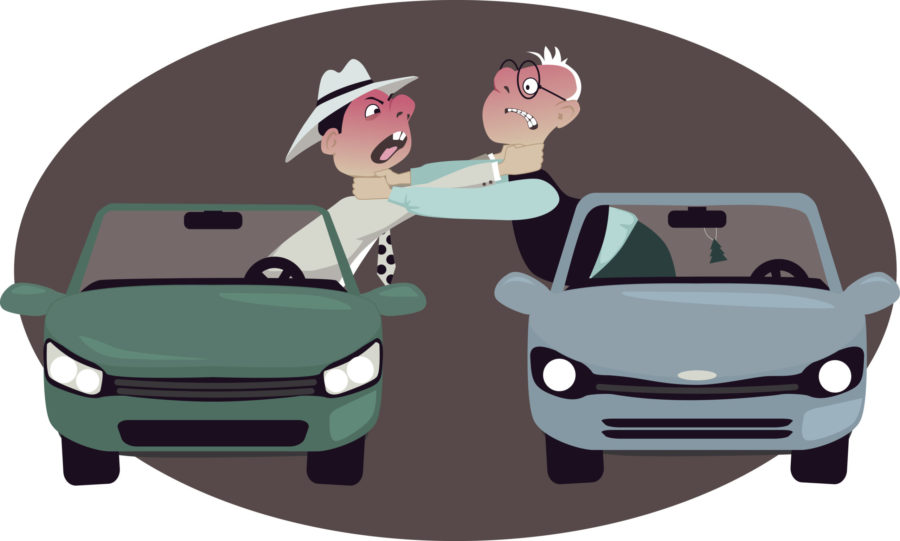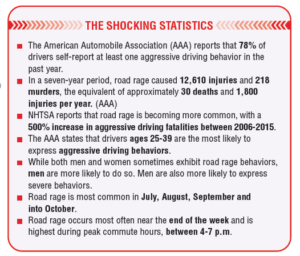Honking horns, yelling, aggressive behavior… chances are good you’ve encountered an angry driver, or, you may be the angry driver. What is road rage, what causes it and what can be done about it?
According to the AAA Foundation for Traffic Safety, aggressive driving is a contributing factor in up to 54% of all fatal motor vehicle crashes in America. This statistic suggests that the anger and frustration that occurs behind the wheel can play a large part in deadly crashes.
What is Aggressive Driving and Road Rage?
The National Highway Traffic Safety Administration (NHTSA) defines aggressive driving as when “an individual commits a combination of moving traffic offenses so as to endanger other persons or property.” Aggressive driving behaviors include tailgating, cutting off other cars, speeding while in heavy traffic, weaving in and out of lanes and even running red lights.
Road rage is a more advanced form of aggressive driving. Yelling at other drivers, using profanity, flashing headlights, hitting the brakes or honking the horn to influence other drivers’ behaviors, driving other cars off the road, or in extreme cases, bumping or intentionally hitting another car to show displeasure are all examples of road rage. Some severe instances also involve weapons. In fact, Florida tops the list for road rage involving a firearm. Between 2014-2016, there were 147 reported road rage cases that involved a firearm across Florida, with Miami and Tampa at the top of the list.
What Causes This Behavior?
The NHTSA reports that the most common reason for aggressive driving is running late. This is also a common excuse for passing on the right and following too closely. The anxiety that drivers feel when trying to get to a destination on time may have implications on their driving safety.
According to the American Psychological Association (APA), psychologist Jerry Deffenbacher, PhD, of Colorado State University conducted a study of anger and aggressive driving and found some key differences in drivers that self-identified as high-anger drivers:
– They get angry faster and tend to behave more aggressively. They’re likely to be angrier throughout the course of the day, not just when driving.
– High-anger drivers tend to have hostile, aggressive thinking patterns and are more likely than other drivers to have thoughts of revenge. They are more likely to experience anxiety, general anger and impulsivity and are more likely to outwardly express anger.
– High-anger drivers take more driving risks such as driving 10-20 miles per hour over the posted speed limit, entering intersections when the light turns red, rapid lane changes and tailgating.
– In driving simulations, high-anger drivers had twice as many car accidents, more near-accidents and more speeding tickets.
Click Image to Enlarge
How Can I Prevent It?
Dr. Deffenbacher found that a treatment of either relaxation techniques only or a combination of relaxation techniques and cognitive restructuring were equally effective in reducing aggressive driving behaviors. Cognitive restructuring involves changing thought patterns to healthier ways of thinking. Relaxation strategies include breathing exercises and other basic relaxation techniques. If you suffer from road rage, try some relaxation strategies before getting behind the wheel or when you feel anger rising in the car. Check out our article on Box Breathing on page 16 for some simple techniques.
Road rage is a common phenomenon that causes safety concerns for all drivers. Before getting behind the wheel, take a moment to take a few deep breaths and relax. Remind yourself that the potential of being late is not worth the risk of injury or death. Resist the urge to retaliate when other drivers act aggressively and do your part to keep Florida’s roads safe.
RELATED ARTICLES
Cracking the Code on Strange Food Reactions
Breathe In, Breathe Out: A Guide to Box Breathing


